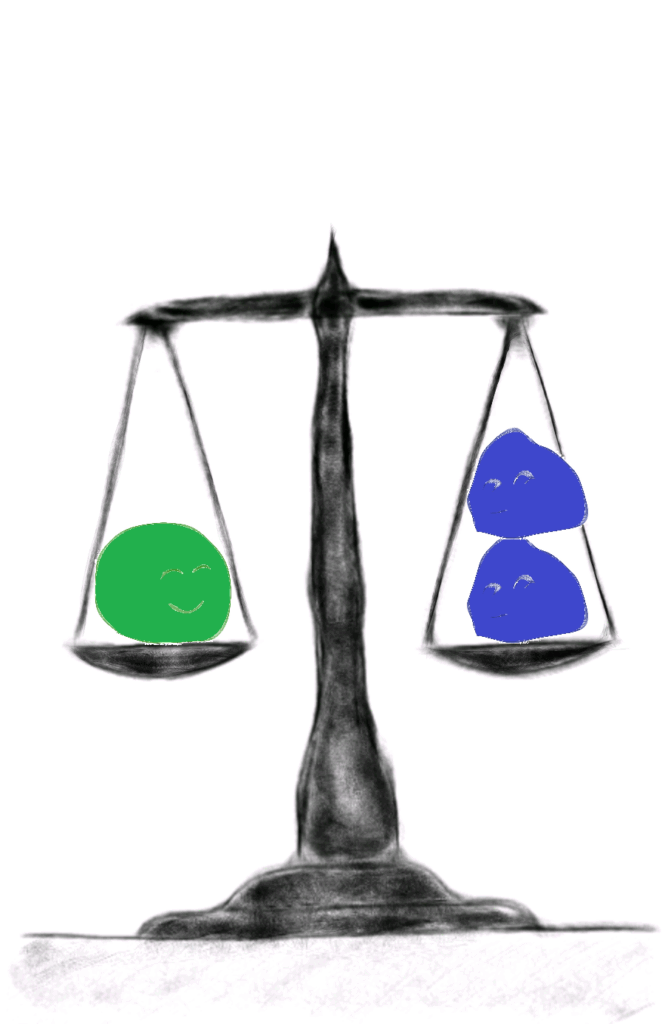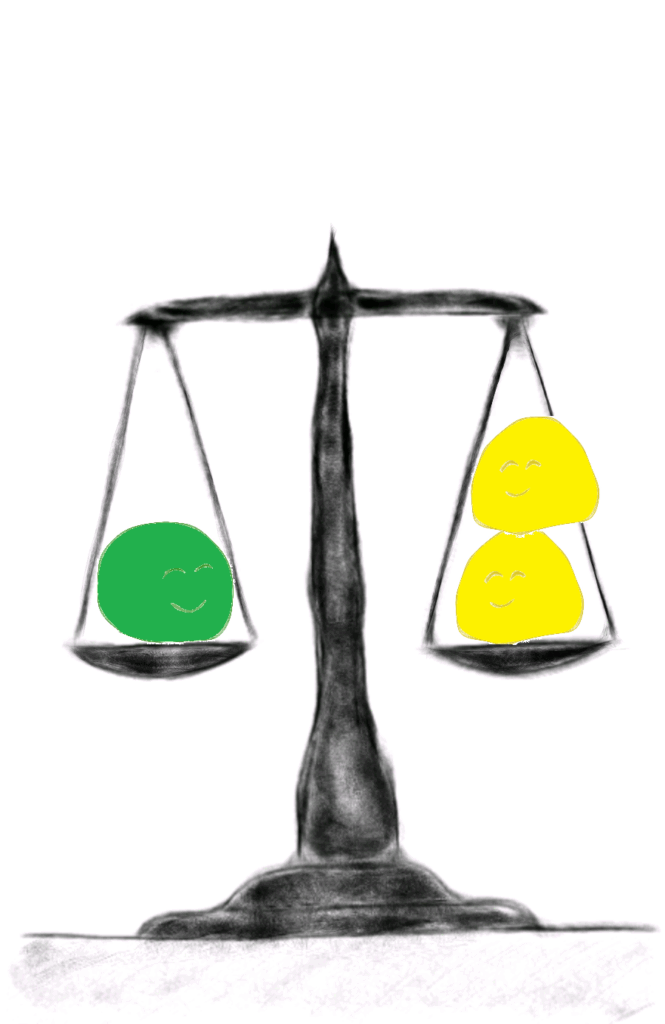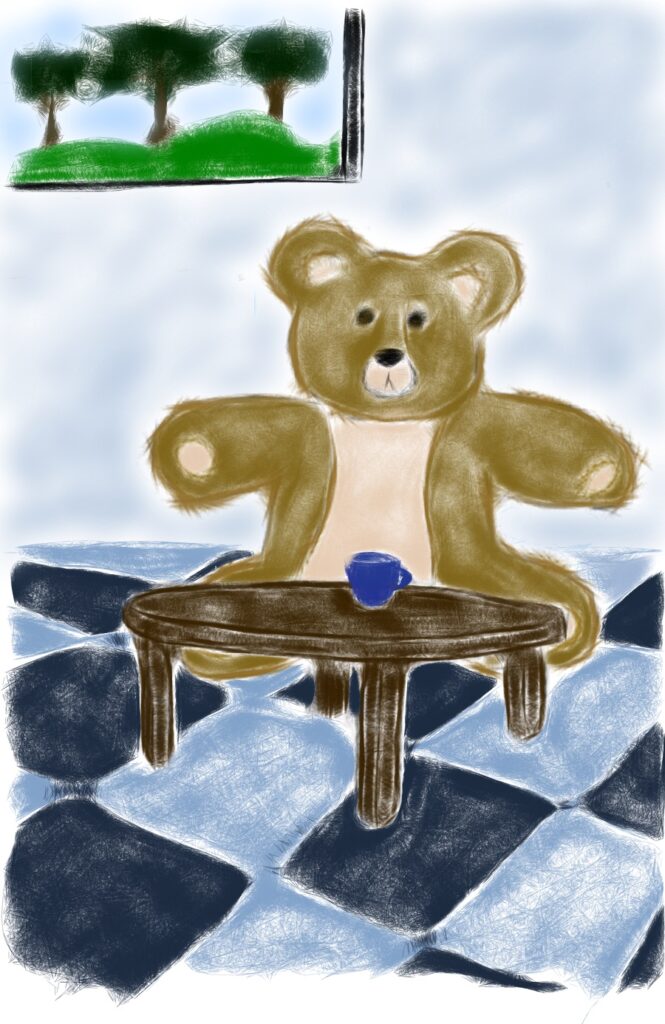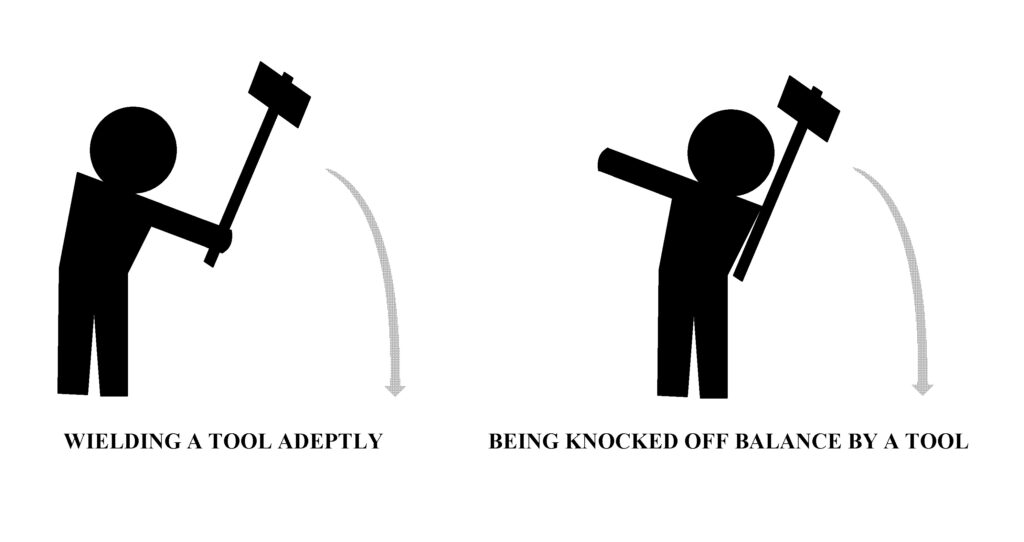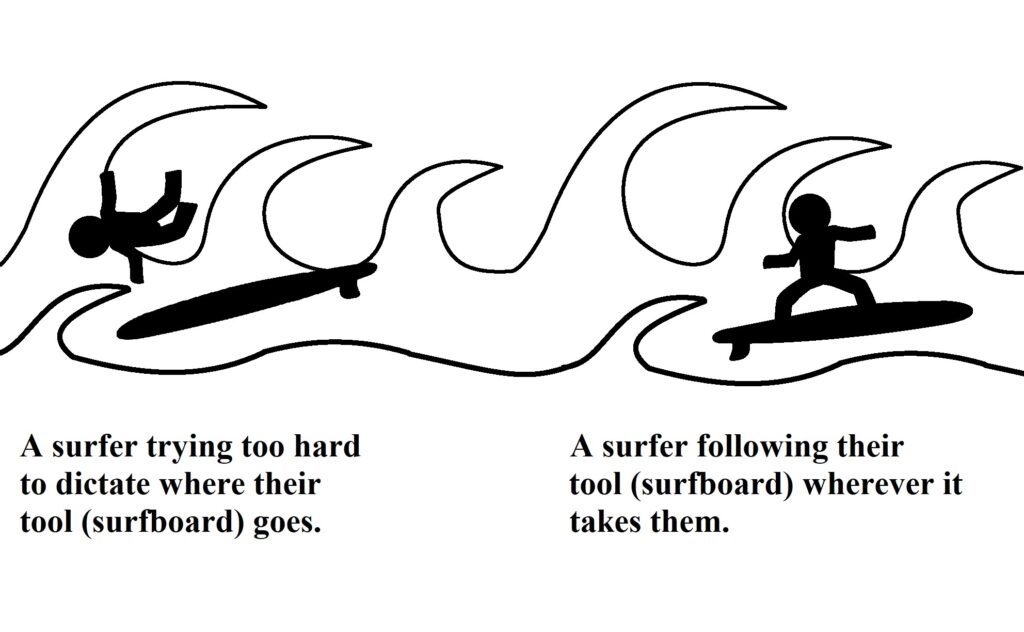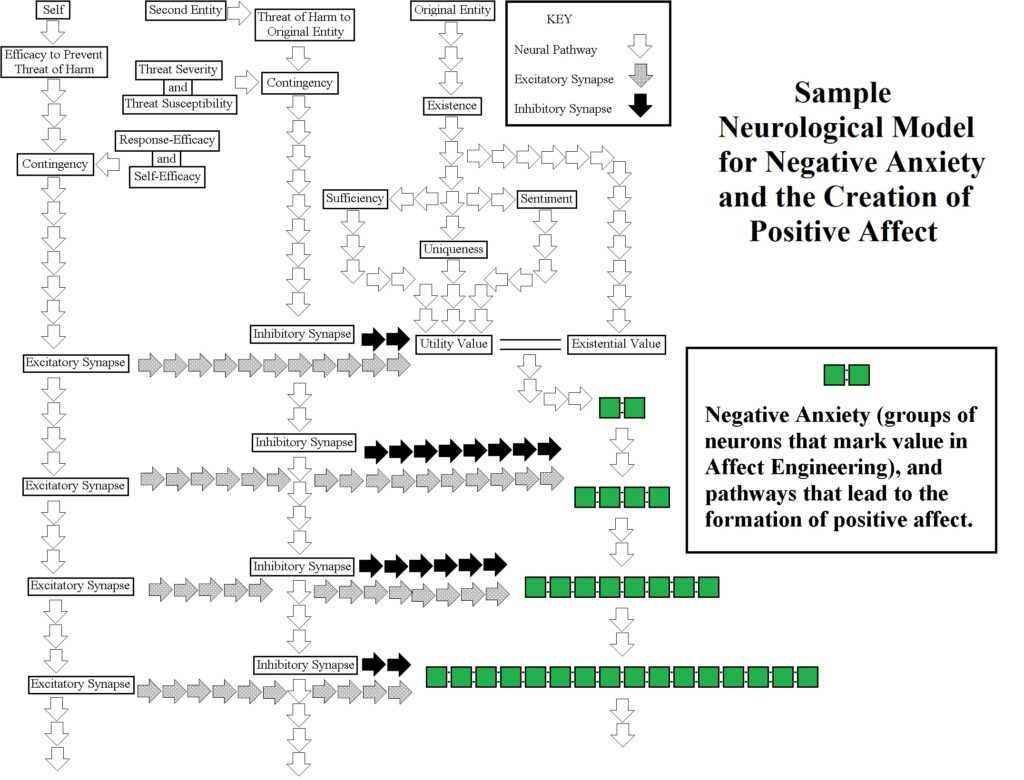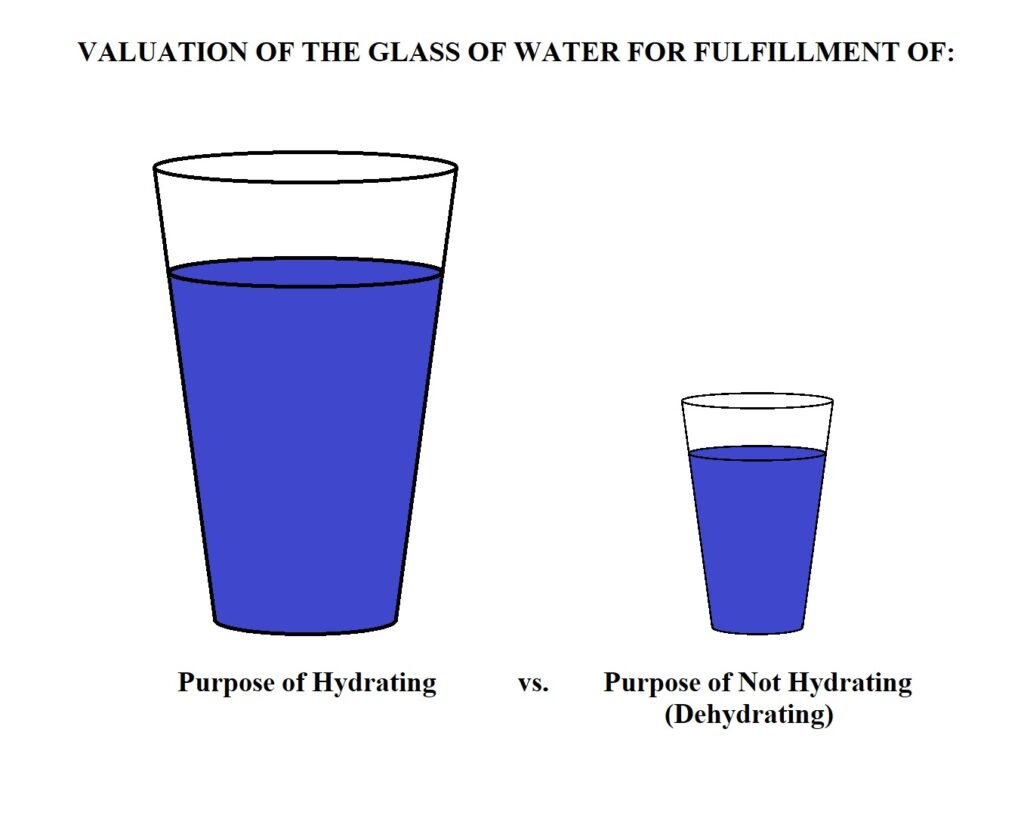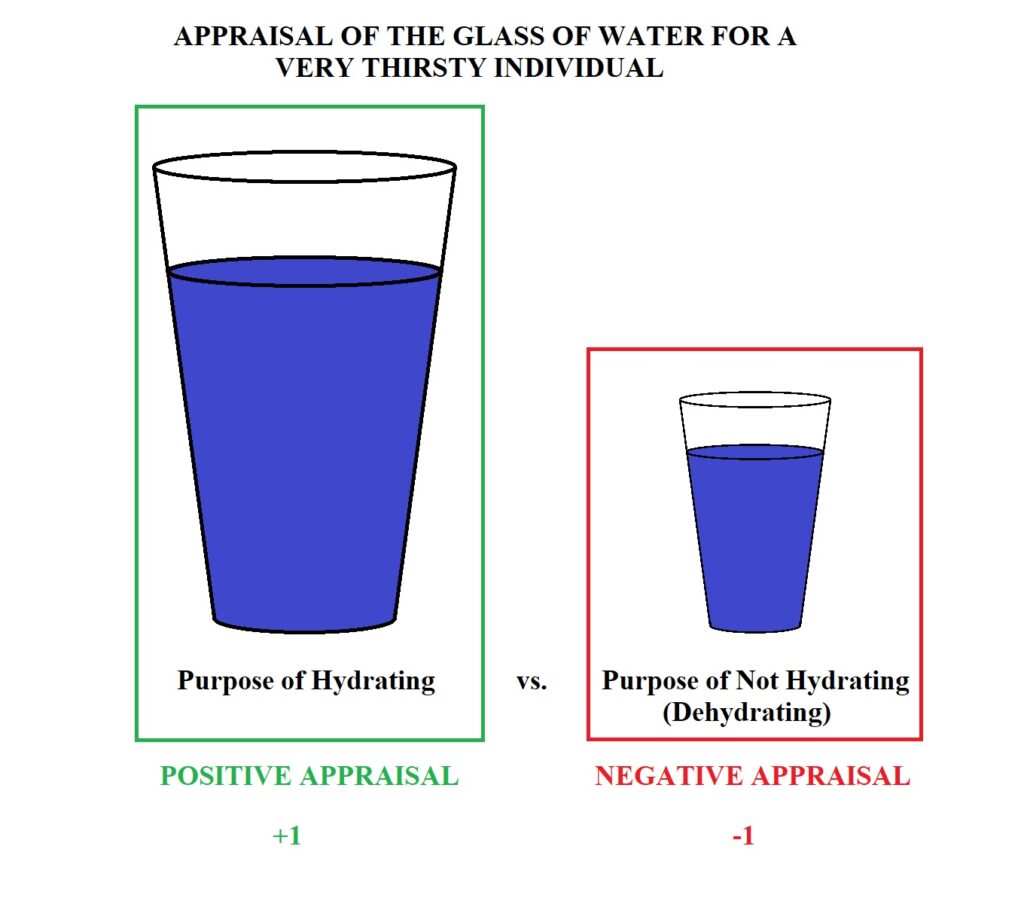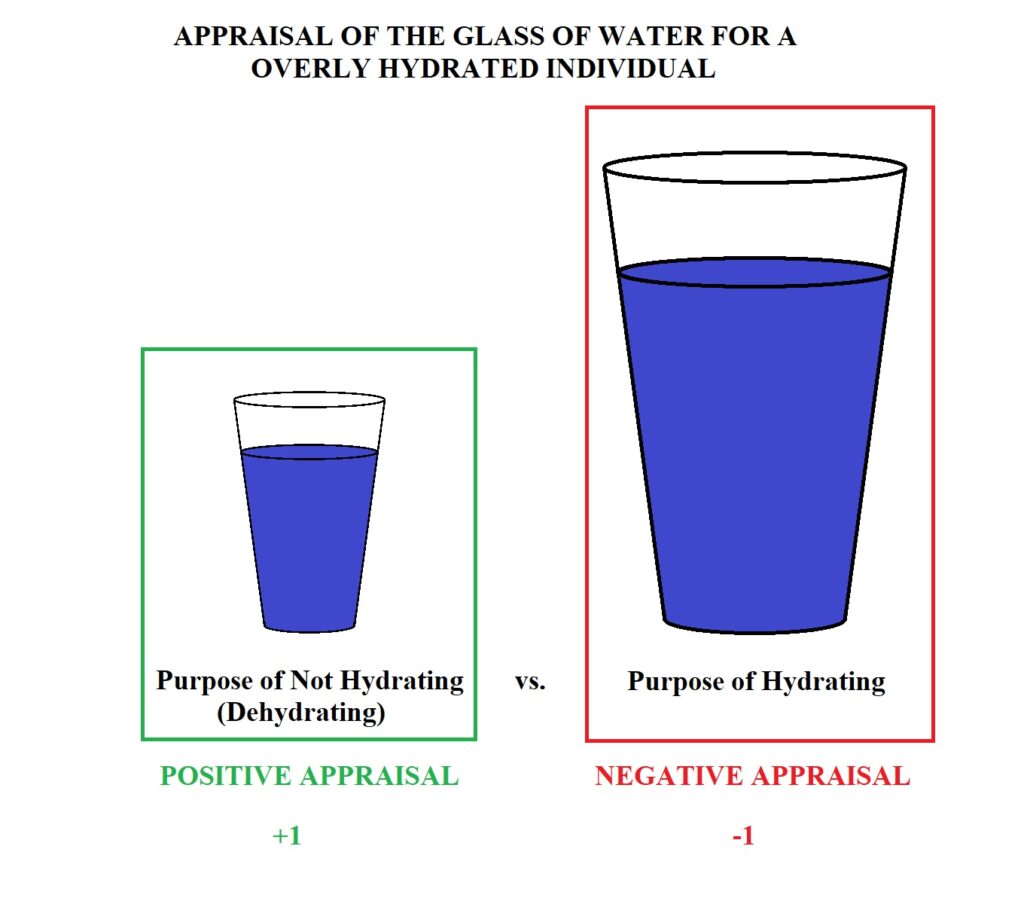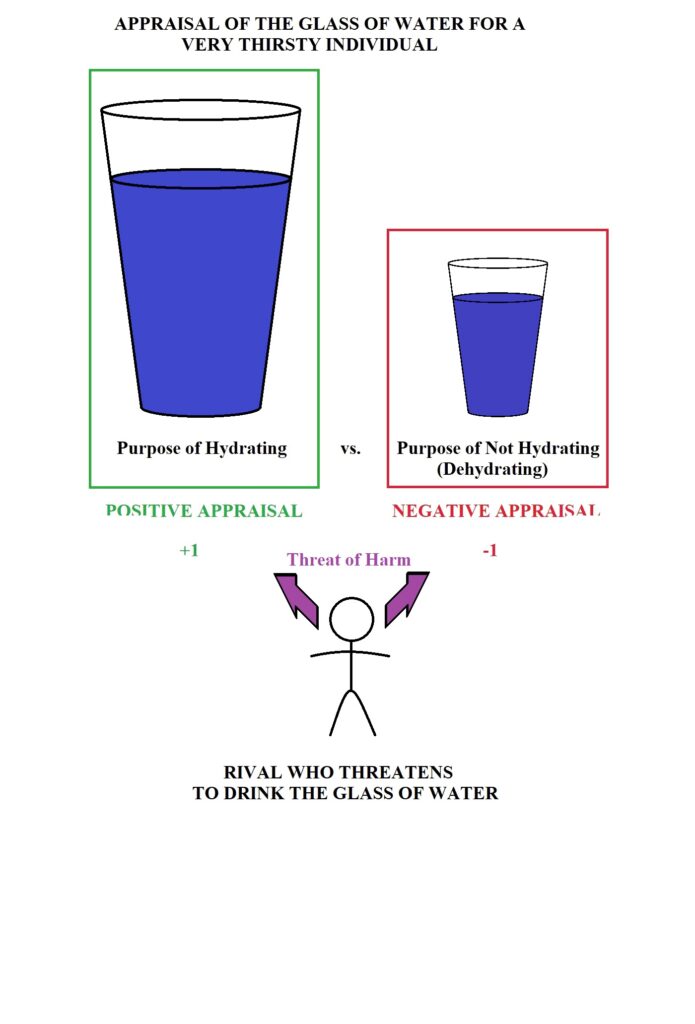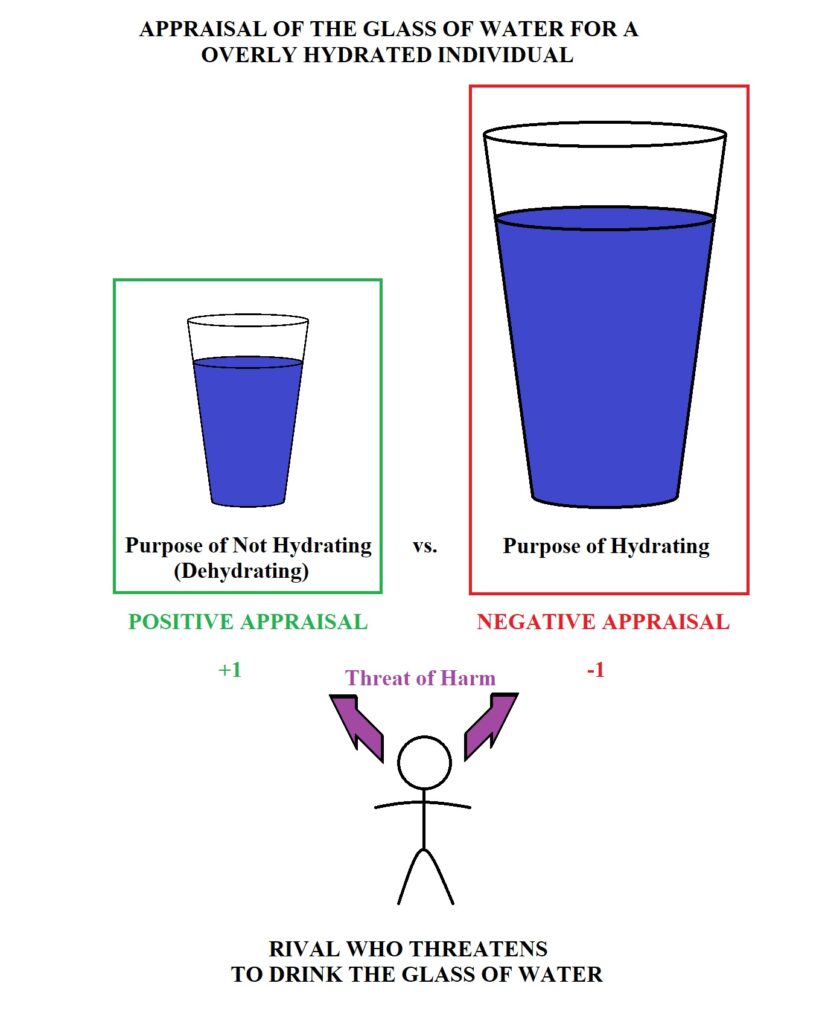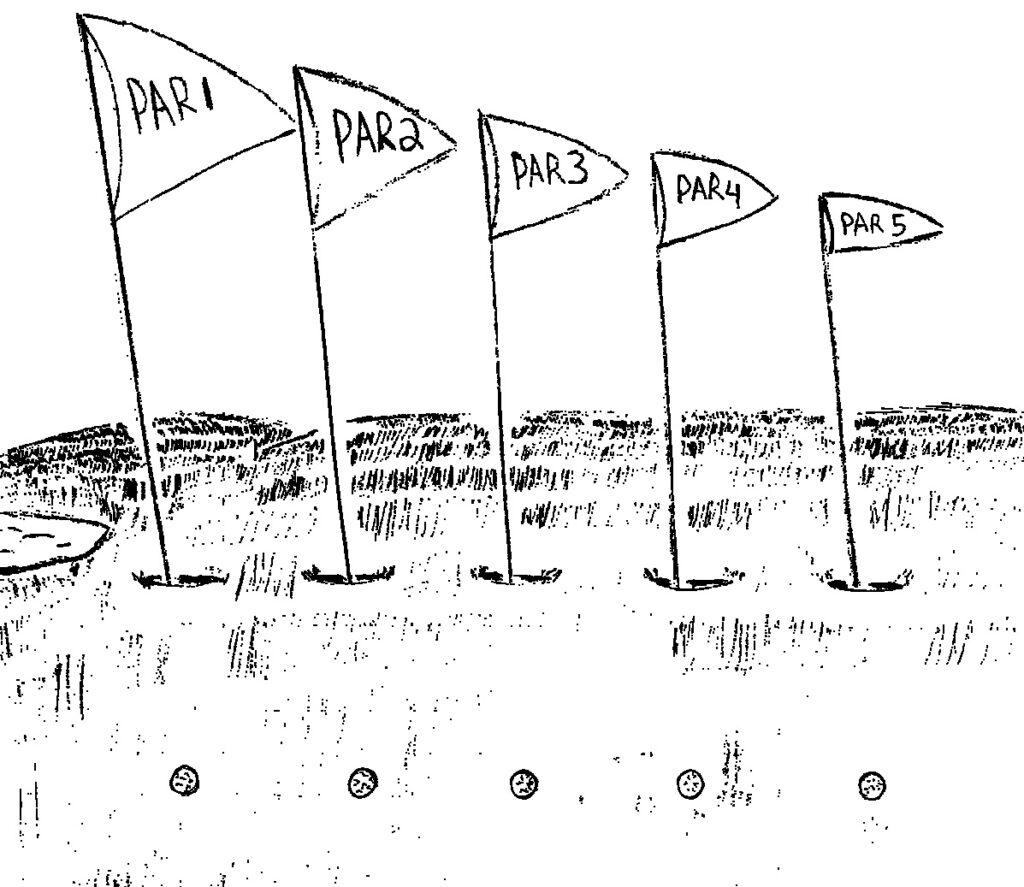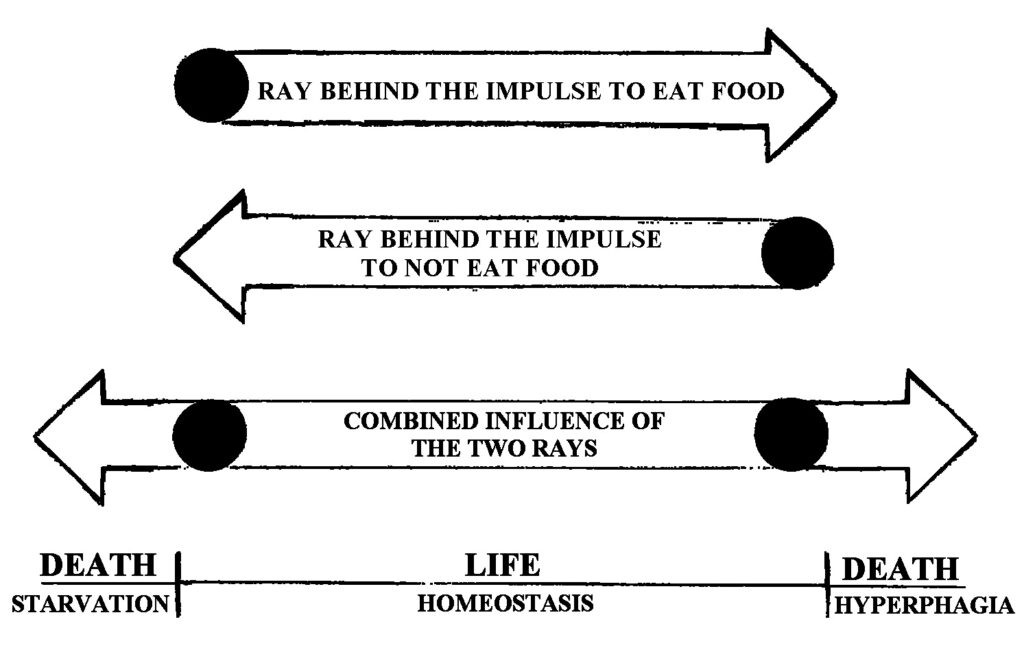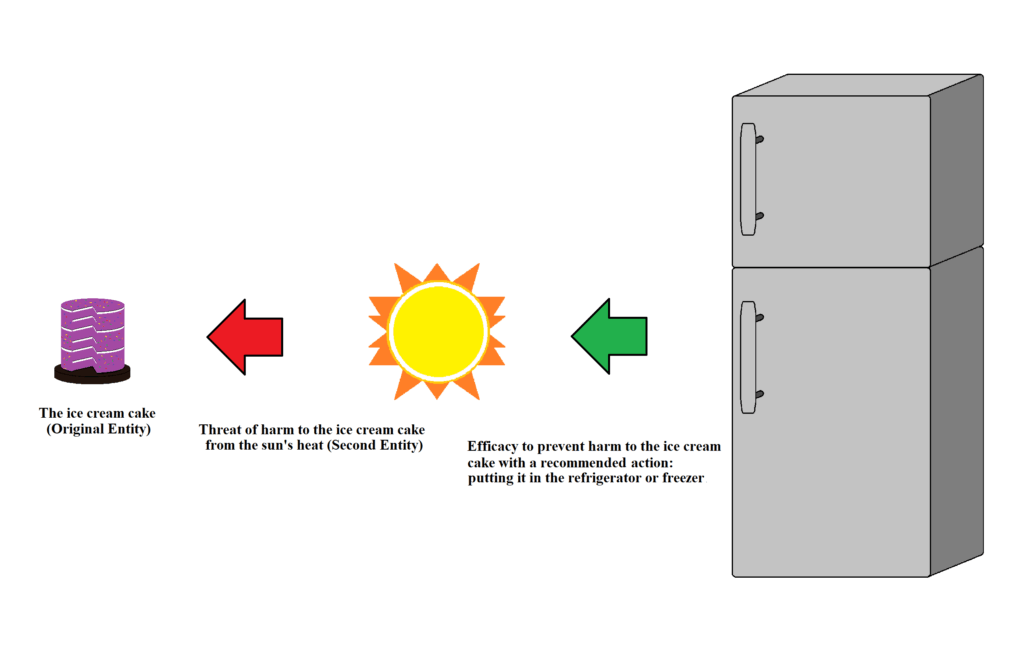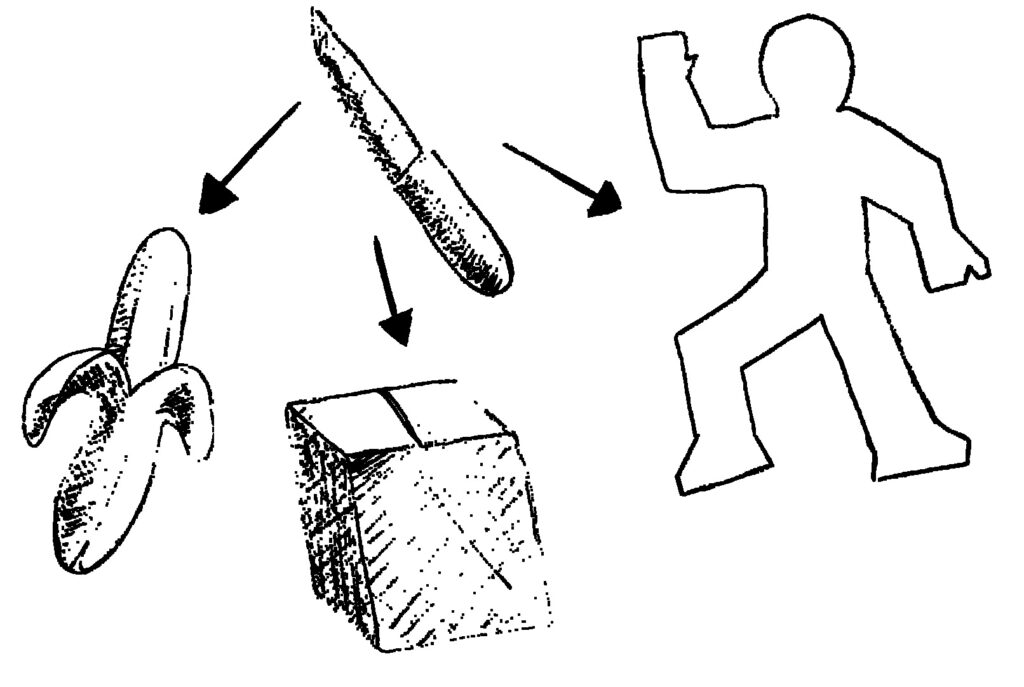Categories of Emotions and Organizing Principles in Affect Engineering
This is the sixth article in a series designed for the layperson and it overviews the organizational principles behind how emotions are classified in Affect Engineering and also provides a general description of many of the basic emotions. It will begin with a list of questions that it aims to address. The sections that follow will be in two parts each. The first part will be a short statement that answers each question as succinctly as possible. The second part will either be an explanation that goes into more detail where needed or explain some of the more nuanced implications of the short answer.
QUESTIONS
- How are emotions organized in Affect Engineering?
- What are the core distinguishing features used to classify emotions in Affect Engineering?
- What would a general description of the main emotions in each category of emotions sound like?
How are emotions organized in Affect Engineering?
SHORT ANSWER
Emotions in Affect Engineering are grouped into one of four categories: Emotions of the Self; Interpersonal Emotions; Compound Interactive Emotions; Emotive States.
IN DEPTH EXPLANATION
Emotions in Affect Engineering are grouped into one of four categories based upon a handful of features. Emotions that concern a single individual’s objectives and that take place over a relatively shorter time frame (e.g., minutes as opposed to days or weeks) are grouped together under Category I Emotions, Emotions of the Self or the Intrapersonal Emotions.
Emotions that involve empathy (e.g., scenarios where individuals imagines themselves in an other party’s position experiencing something) where they vicariously experience the other party’s success or failure in a passive manner without attempting to influence the outcome are grouped together under Category II Emotions. These are called the Interpersonal Emotions or the Four Degrees of Empathy in Affect Engineering.
Emotions that involve empathy and where individuals are attempting to influence the outcome of the other party’s situation while they are vicariously experiencing their success or failure are grouped together under Category III Emotions. These are called the Compound Interactive Emotions.
Lastly, emotions that are influenced more heavily by the amount of elapsed time, that are somewhat more unique in how they arise, or that are characterized by an interplay between multiple objectives (e.g., three or more objectives) are grouped together under Category IV Emotions, the Emotive States.
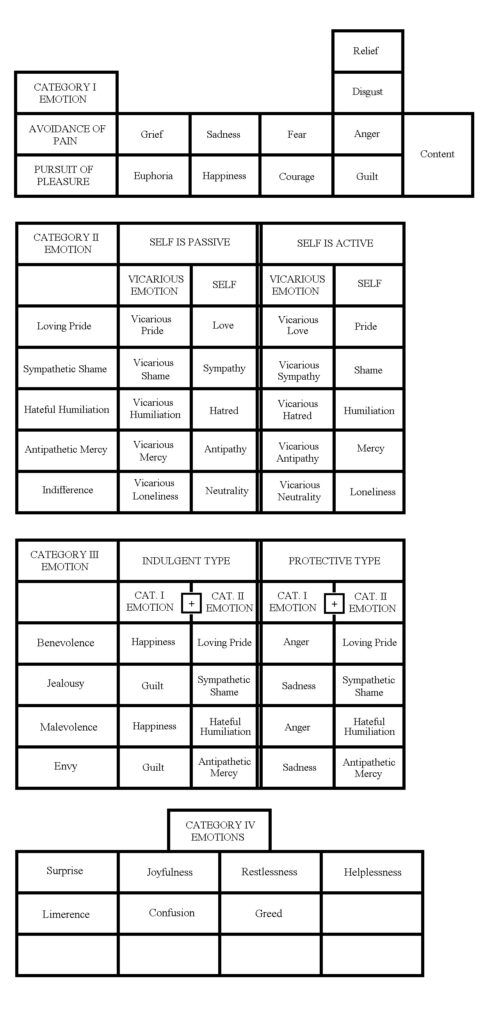
The Four Categories of Emotions in Affect Engineering. In the Category I Emotions, Anger, Disgust, and Relief are all grouped under Avoidance of Pain and would possess similar graphs, but differ in the response by the Self (i.e., Aggression, Evasion, Neither). Content is grouped under both the Avoidance of Pain and Pursuit of Pleasure subcategories. Category II and Category III Emotions involve empathy. Category IV Emotions include emotive states and miscellaneous emotions; it is a bit more expansive than the other three categories.
What are the core distinguishing features used to classify emotions in Affect Engineering?
SHORT ANSWER
The core distinguishing features used to classify emotions in Affect Engineering are primarily derived from answers to the following questions:
- At what rate is the individual’s valuation of an entity for a purpose changing?
- What is the Appraisal of an entity, and will its acquisition lead towards or away from restoring equilibrium between the purpose at hand and its complementary purpose?
- Is empathy is involved?
- If empathy is involved, is the self actively attempting to influence the outcome for the other party’s success or failure, or is the self simply observing and vicariously experiencing the other party’s situation in a passive manner?
- What is the time frame over which an entity’s valuation is changing? Is it a drastic change?
- Is there an interplay between three or more purposes or other variables in the functions?
- What type of response is the self engaging in (e.g., aggressive, evasive, or neither)?
IN DEPTH EXPLANATION
The main feature used to distinguish one emotion from another in Affect Engineering is the rate of change in an entity’s valuation for the fulfillment of a purpose. For Category I Emotions, Emotions of the Self, the rate of change of an entity’s valuation for a purpose over time is the primary distinguishing feature between different emotions. This value may be increasing or decreasing at either an accelerating rate or a deaccelerating rate. It may also be staying the same.
The Appraisal of an entity, which is concerned with whether the entity’s acquisition will lead towards a restoration of equilibrium between a purpose and its complementary purpose or away from equilibrium, determines whether an Avoidance of Pain function is used as opposed to a Pursuit of Pleasure function. Each of these types of functions has different emotions that fall under their domains, although the emotion of Content is an exception as it falls under both. The Avoidance of Pain emotions under Category I Emotions include: Sadness, Grief, Fear, Anger, Disgust, Relief, and Content. The Pursuit of Pleasure emotions under Category I Emotions include: Happiness, Euphoria, Courage, Guilt, and Content.
Empathy, or the self imagining itself experiencing a situation as another party, is present in all Category II, all Category III Emotions, and in some Category IV Emotions. In the case of Category II Emotions, the self’s vicarious experience is purely passive, akin to watching a movie and identifying with one of the characters in it. In the case of Category III Emotions, the self is actively attempting to influence the outcome of the situation for the another while also vicariously experiencing the other’s success or failure.
Category IV Emotions, or Emotive States, are those where the duration of the situation is taken into consideration when classifying an emotion; Category Four Emotions also include emotions that are characterized by an interplay between three or more objectives, and this category includes emotions that arise due to specific variables in the functions that may be consistently elevated, depressed, unknown, or fluctuating wildly, among several other possibilities.
Lastly, regarding the self’s response type (e.g., to a threat of harm to an entity), if the self’s response involves aggression and moving against a threat of harm, attempts to evade a threat of harm, or neither of these, then this would alter the classification of the emotion being expressed. This applies primarily to the Category I Emotion of Anger, and is used to distinguish Anger from both Disgust and from Relief.
What would a general description of the main emotions in each category of emotions sound like?
SHORT ANSWER
Category I Emotions, the Intrapersonal Emotions, include the emotions related to purposes that only concern the self, and no empathy is involved. They are: Sadness; Grief; Fear; Anger; Content; Happiness; Euphoria; Courage; Guilt, Disgust, Relief.
Category II Emotions, the Interpersonal Emotions, or Four Degrees of Empathy, include the emotions that concern the self and others when the empathizing party is passive and not actively trying to influence the outcome of the other. They are: Love and Vicarious Pride; Pride and Vicarious Love; Sympathy and Vicarious Shame; Shame and Vicarious Sympathy; Hatred and Vicarious Humiliation; Humiliation and Vicarious Hatred; Antipathy and Vicarious Mercy; Mercy Vicarious Antipathy; Neutrality, Vicarious Loneliness; Loneliness, Vicarious Neutrality.
Category III Emotions, the Compound Interactive Emotions, concern the self and others when the empathizing party is actively trying to influence the outcome of the other. They are: Benevolence; Jealousy; Malevolence; Envy. Each of the these four emotions may also be one of two types, Indulgent or Protective. Category III Emotions are comprised of both a Category I and a Category II emotion.
Category IV, the Emotive States, often concern the time frame over which some valuations are established, and include emotions that are characterized by the interplay between multiple purposes or variables within the functions. Some examples include: Surprise; Joyfulness; Restlessness; Helplessness; Confusion; Limerence. Other more culturally specific, obscure, or lesser known emotions would likely fall under this category if they cannot be explained by the other three Categories.
IN DEPTH EXPLANATION
A brief explanation of each emotion along with a sample graph where applicable, follows below. A more in depth explanation of each of the emotions along with examples, descriptions of what variables in the functions could lead to these emotions arising, how the self can regulate these emotions, and instances of other miscellaneous emotions will follow in the remaining six articles (articles 7-12).
The Category I Emotions: Intrapersonal Emotions
Sadness
Sadness felt for a particular entity is characterized by an individual’s valuation of the entity rising at a steady rate. This could be due, for instance, to the entity becoming more difficult to acquire.

Grief
Grief felt for a particular entity is characterized by an individual’s valuation of the entity rising at an accelerating rate, oftentimes approaching a vertical asymptote (i.e., towards positive infinity). A steep slope or a vertical asymptote could arise due to the self’s realization that the entity is either nearly impossible to attain or no longer attainable at all.
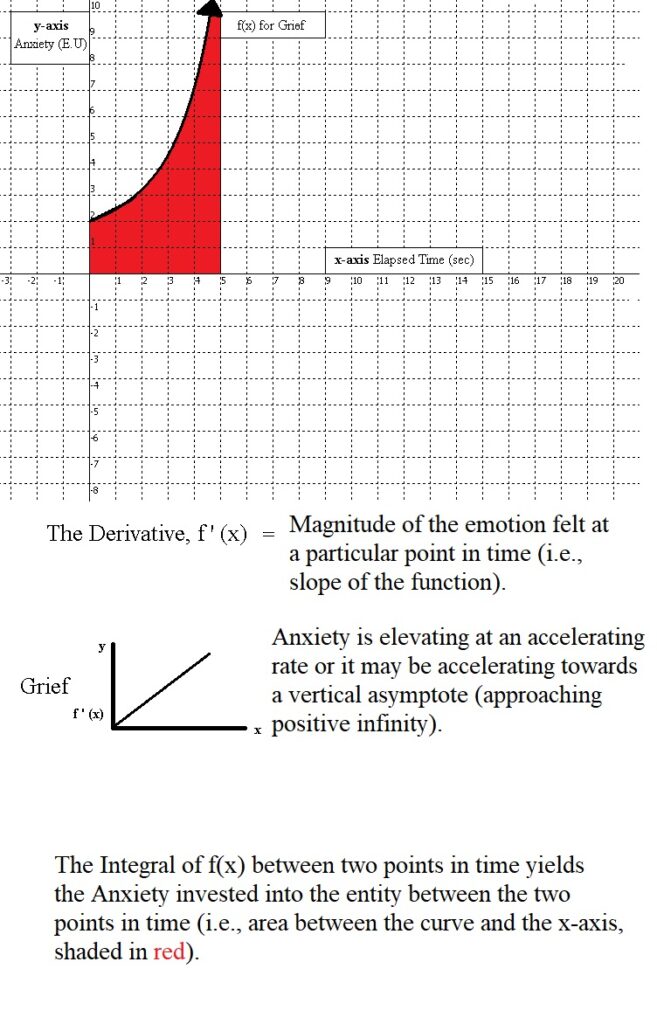
Fear
Fear felt for a particular entity is characterized by an individual’s valuation of the entity initially being low and somewhat uncertain before rising and tapering off again. This could be due to new information becoming available concerning a threat of harm to an entity or the inability to prevent the threat of harm (e.g., low efficacy and a high probability of the harm happening). This could happen if a threat of harm was initially dismissed as negligible, but is later revealed to be significant.
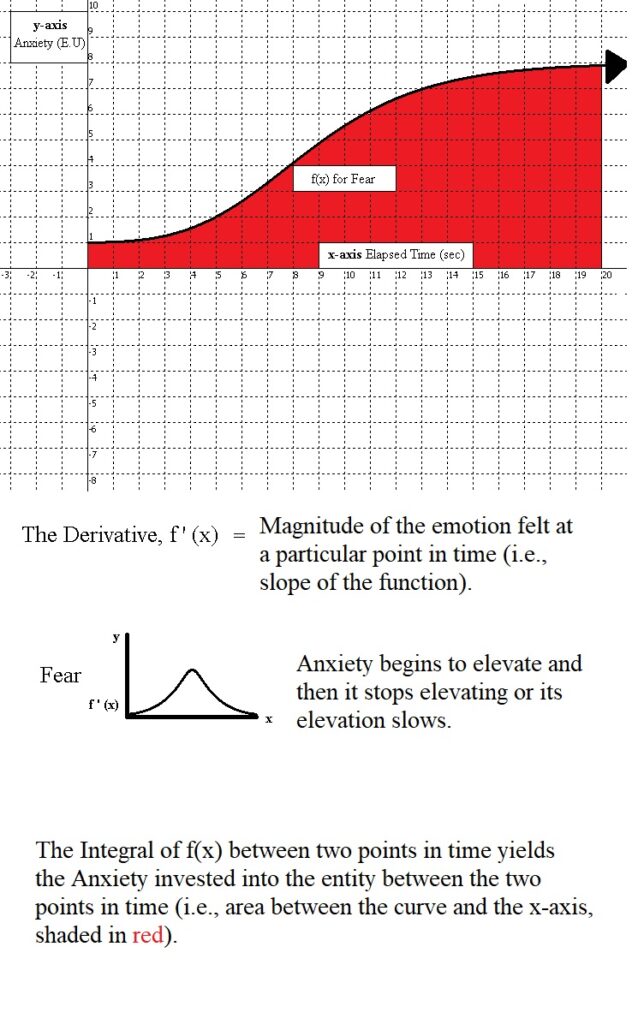
Anger, Disgust, and Relief
Anger felt for a particular entity is characterized by an individual’s valuation of the entity lowering and the presence of aggression against a threat of harm to it; aggression distinguishes Anger from the emotions of Disgust and Relief. Anger’s presence would be indicated by the self actively eliminating a threat of harm, that is to say, demonstrating aggression against it.

Disgust felt for a particular entity is also characterized by an individual’s valuation of the entity lowering. However, evasion or evasive action is the critical component in this case; evasive action distinguishes Disgust from the emotions of Anger and Relief. Disgust could arise due to the self taking action to successfully evade a threat of harm to the entity, for instance, by moving the entity away from the threat of harm.

Relief felt for a particular entity is characterized by an individual’s valuation of the entity lowering, but without aggression or evasion; the lack of aggression or evasive action distinguishes Relief from the emotions of Anger and Disgust. Relief could arise due to the threat of harm to the entity simply not happening, or the threat of harm having a low likelihood and becoming negligible through chance.

Content
Content felt for a particular entity is characterized by an individual’s valuation of the entity remaining the same or at a low level, such as at or near its existential value. This could be due to the entity simply not having all that much importance to the individual, or if the entity’s valuation has remained steady for an extended period of time and is being used as a benchmark of sorts to compare against other entities. Valuations for two separate entities are listed below on the same graph.
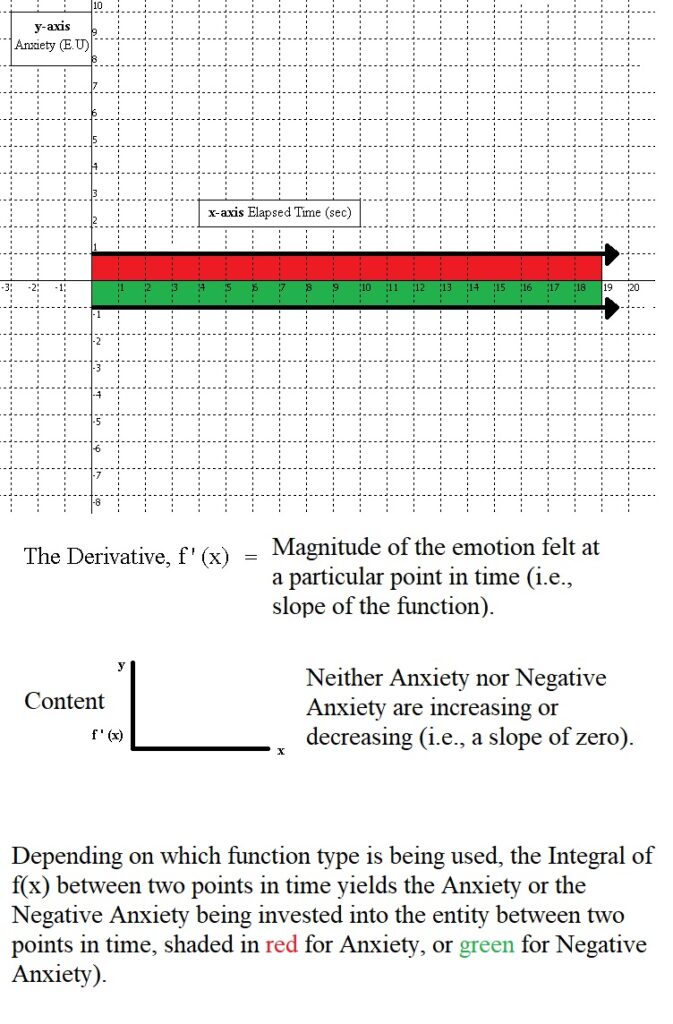
Happiness
Happiness felt for a particular entity is characterized by an individual’s valuation of the entity descending at a steady rate towards negative infinity. It is important to keep in mind that the negative symbol here (-), for Negative Anxiety, does not symbolize good or bad, but simply means that further acquisition of the entity will lead away from equilibrium between the purpose at hand and its complement or opposing purpose. The entity is already in ample supply, and further acquisition of it is akin to increasing a stockpile of a resource that is already possessed in a sufficient amount. In contrast, for emotions gauged with Anxiety (i.e., Positive Anxiety), the positive Appraisal value implies that acquiring the entity will lead towards a restoration of equilibrium.
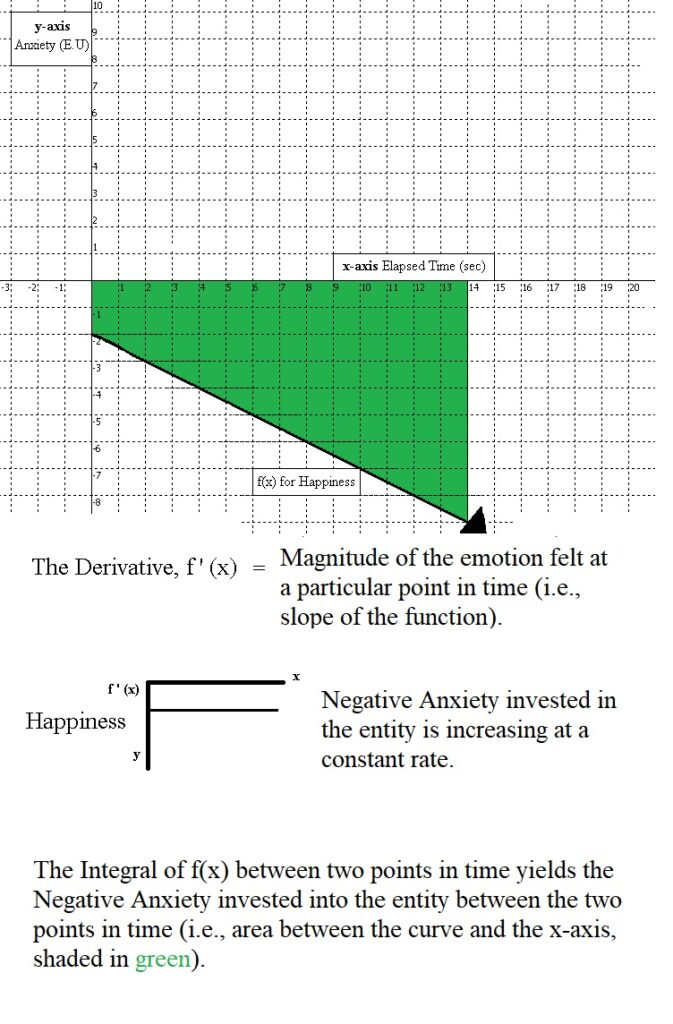
Euphoria
Euphoria felt for a particular entity is characterized by an individual’s valuation of the entity descending at a steady rate towards negative infinity. Similarly to Happiness, the entity is already in ample supply, and further acquisition of it is akin to increasing a personal stockpile. Approaching a vertical asymptote could be due to an instance of extremely good fortune, such as winning the lottery or becoming obsessed with and successfully collecting a specific entity, or suddenly acquiring the means to engage in an enjoyable activity such as traveling. The primary risk here arises from other entities and objectives that are being ignored or neglected, as euphoria felt for successfully acquiring a specific entity in excess for the fulfillment of the purpose will necessarily come at the expense of successfully achieving other objectives that the individual is not fulfilling.

Courage
Courage felt for a particular entity as it relates to the fulfillment of a purpose is characterized by an individual’s valuation of the entity initially having a low absolute value (i.e., closer to zero) and being somewhat uncertain before increasing and tapering off again. It is similar to the graph for Fear in this sense, but because Negative Anxiety is used its value descends negatively towards negative infinity before tapering off again. Like for courage, this could be due to the availability of new information concerning a threat of harm to an entity or the inability to prevent the threat of harm (e.g., high efficacy or a low probability of the threat of harm to the entity). If the acquisition of an entity initially seemed unattainable, but new information later suggests that the individual can more easily acquire it, then they would feel emboldened or encouraged to obtain the entity under this model.
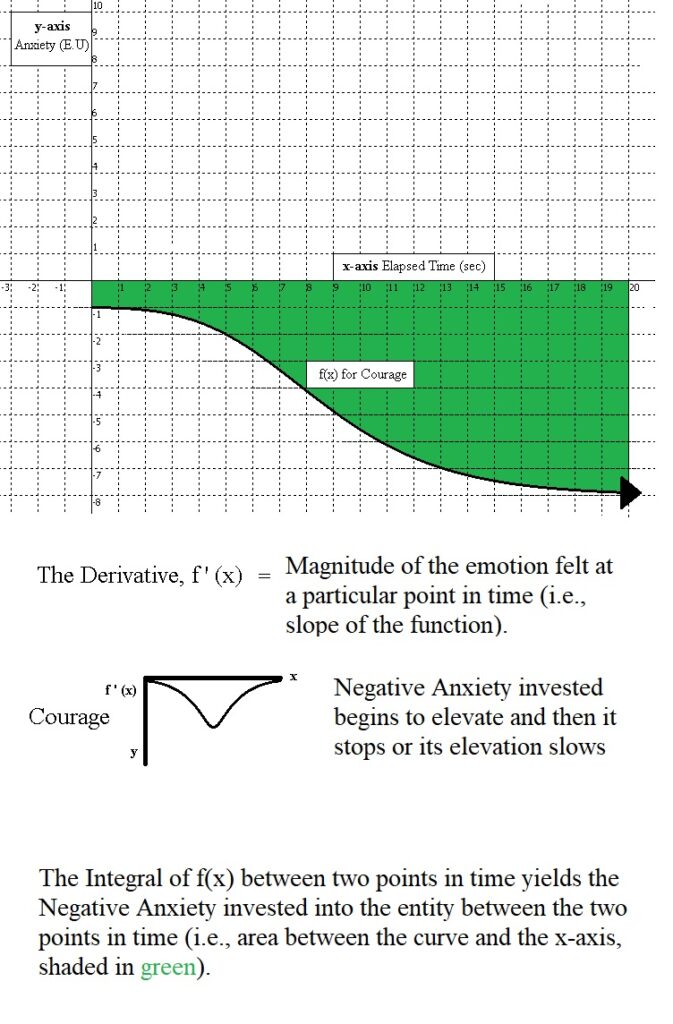
Guilt
Guilt felt for a particular entity is characterized by an individual’s valuation of the entity initially having a high absolute value, and then rising towards its existential value (i.e., its absolute value diminishes and returns closer towards one in this case). Guilt is modeled as a missed opportunity by an individual in Affect Engineering, and this could arise due to the self initially possessing a good chance or favorable odds to acquire the entity (e.g., high initial efficacy and low threat components), but failing to acquire the entity nonetheless. This often times happens with procrastination for individuals, where they may have initially had time to complete a task, but because they failed to act with urgency, they end up not succeeding.
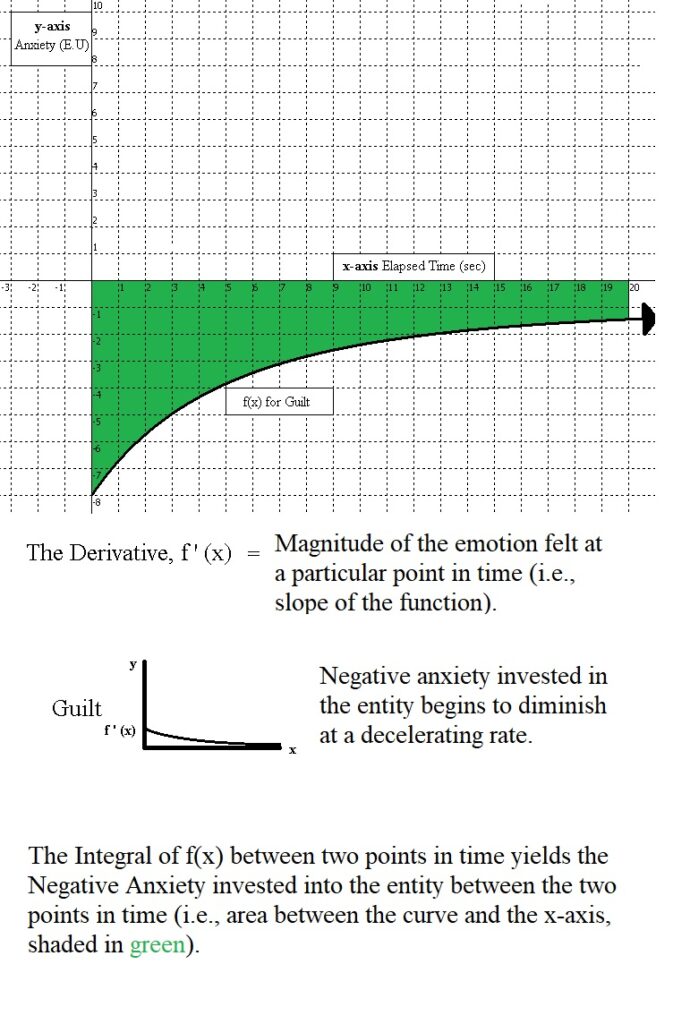
The Category II Emotions: Interpersonal Emotions or the Four Degrees of Empathy
All of the Category II Emotions involve empathy. However, the party that is vicariously experiencing the other party’s success or failure only does so passively. They do not attempt to influence the outcome of the other party’s situation, and oftentimes cannot interact with the other party. They only observe and mirror them.
When the self is the passive party, they will feel either Love and Vicarious Pride, Sympathy and Vicarious Shame, Hatred and Vicarious Humiliation, or Antipathy and Vicarious Mercy.
When the self is the active party and is aware that they are being passively observed by someone empathizing with them, then the roles essentially flip. The self vicariously experiences the other party vicariously experiencing their situation. That is to say, the self imagines they are another party imagining that they are the original individual. When this happens, Pride and Vicarious Love, Shame and Vicarious Sympathy, Humiliation and Vicarious Hatred, or Mercy and Vicarious Antipathy may be felt by the self in Affect Engineering’s framework.
Love and Vicarious Pride; Pride and Vicarious Love
Love and Vicarious Pride felt for another party are characterized by the self wanting the other party to succeed, and the other party does succeed. This may take one of two forms, depending on which functions are being used for the self (top left and bottom left graphs of the next two images) and their vicarious valuation of the other party (top right and bottom right graphs of the next two images).
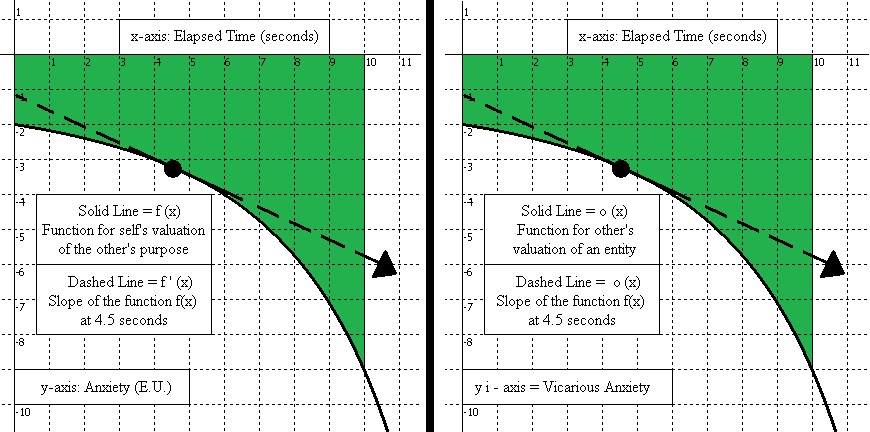
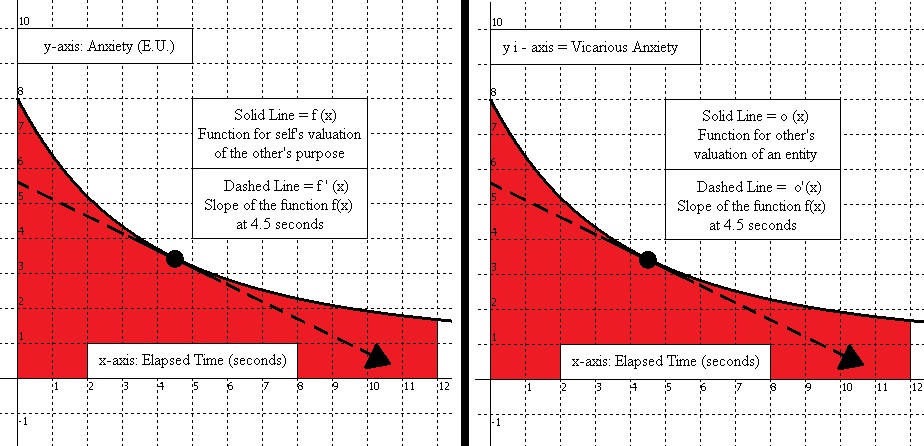
For Pride and Vicarious Love, the self would have agency and the graphs would be flipped, with the self’s valuation of an entity being on the right, and their imagining of the other party vicariously experiencing their success on the left . . . vicariously experiencing the other party wanting to vicariously experience the self’s own success and the self succeeds.
Sympathy and Vicarious Shame; Shame and Vicarious Sympathy
Sympathy and Vicarious Shame felt for another party are characterized by the self wanting the other party to succeed, but the other party fails. This may take one of two forms, depending on which functions are being used for the self (top left and bottom left graphs of the next two images) and their vicarious valuation of the other party (top right and bottom right graphs of the next two images).
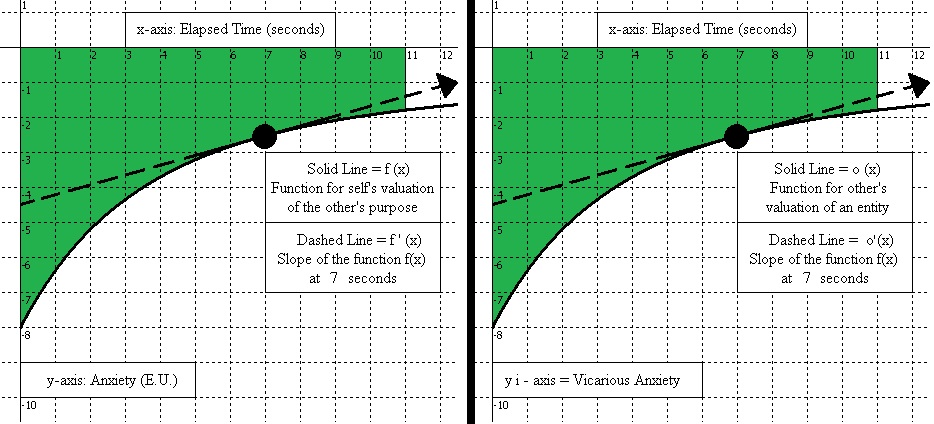
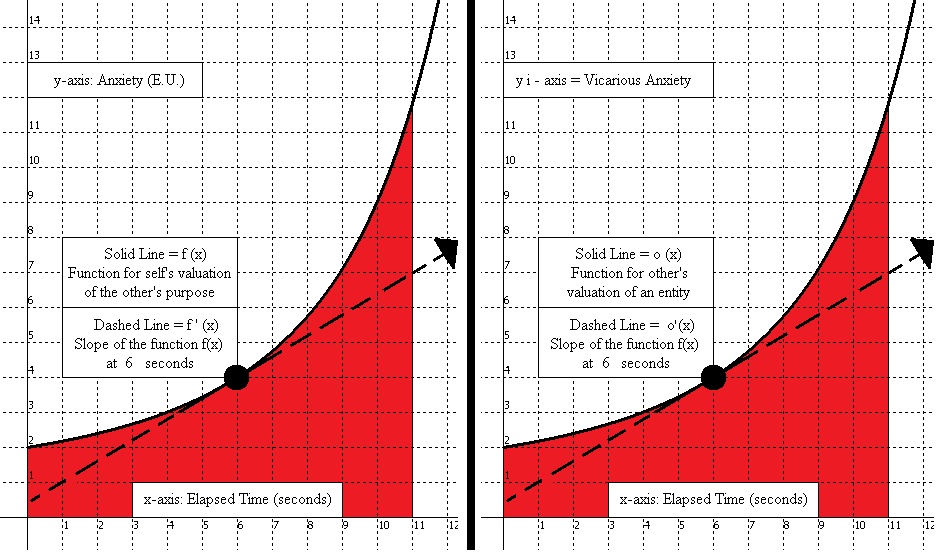
For Shame and Vicarious Sympathy, the self would have agency and the graphs would be flipped, with the self’s valuation of an entity being on the right, and their imagining of the other party vicariously experiencing their failure on the left. In contrast to Vicarious Love, with Vicarious Sympathy the self would be vicariously experiencing the other party wanting to vicariously experience the self’s own success, but because the individual failed then that awareness of the disappointment (Shame) is felt along with Vicarious Sympathy.
Hatred and Vicarious Humiliation; Humiliation and Vicarious Hatred
Hatred and Vicarious Humiliation felt for another party are characterized by the self wanting the other party to fail at their objective, and the other party does fails. This may take one of two forms, depending on which functions are being used for the self (top left and bottom left graphs of the next two images) and their vicarious valuation of the other party (top right and bottom right graphs of the next two images).
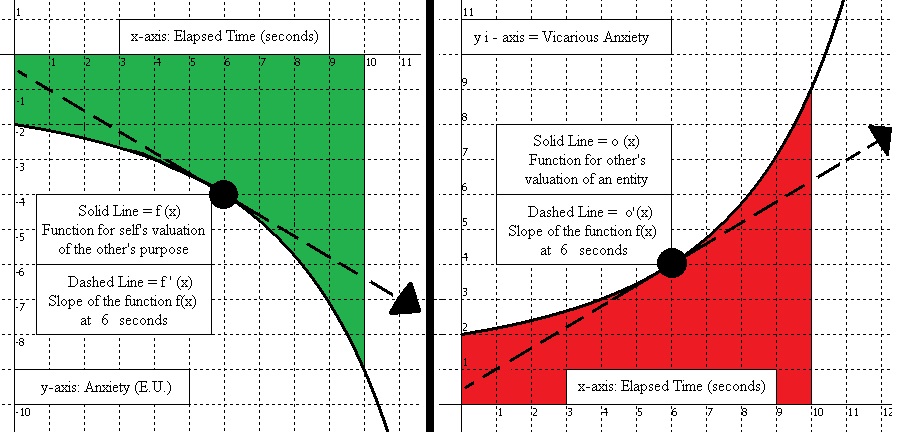
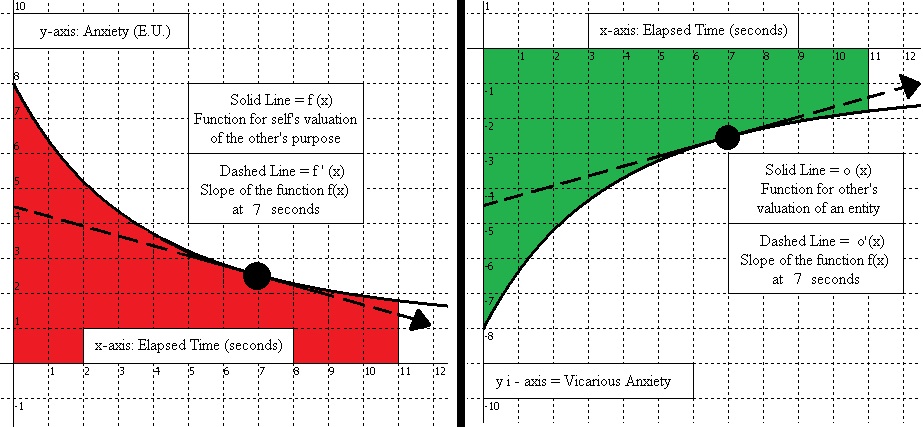
For Humiliation and Vicarious Hatred, the self would have agency and the graphs would be flipped, with the self’s valuation of an entity being on the right, and their imagining of the other party vicariously experiencing delight at their failure on the left . . . vicariously experiencing the other party wanting to vicariously experience the self’s own failure, and the self ultimately fails. This could arise from the other party feeling like the self did not deserve to achieve whatever goal was sought.
Antipathy and Vicarious Mercy; Mercy and Vicarious Antipathy
Antipathy and Vicarious Mercy felt for another party are characterized by the self wanting the other party to fail at their objective, but the other party ultimately succeeds. Vicarious Mercy in this sense is the sensation by the self that the other party either avoided a harm that they deserved or achieved a goal that they did not deserve to achieve. This may take one of two forms, depending on which functions are being used for the self (top left and bottom left graphs of the next two images) and their vicarious valuation of the other party (top right and bottom right graphs of the next two images).
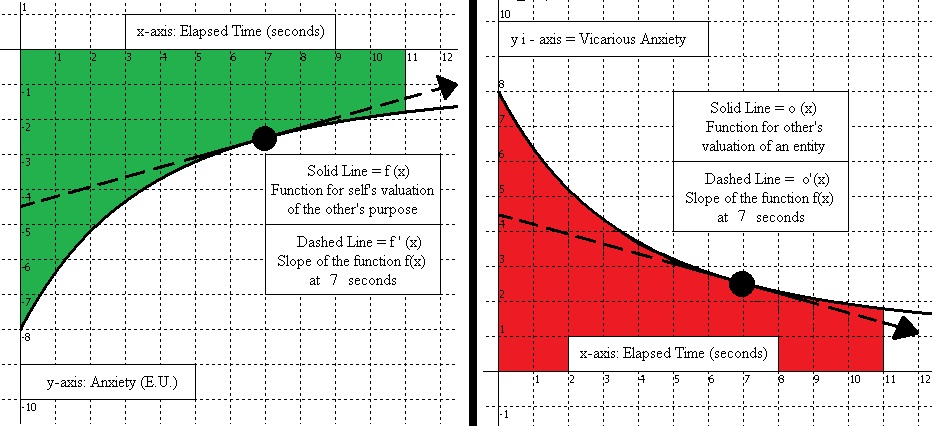
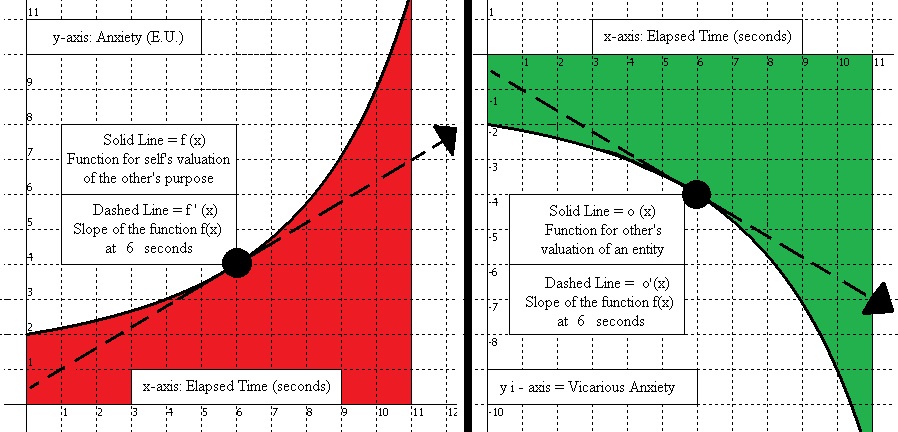
For Mercy and Vicarious Antipathy, the self would have agency and the graphs would be flipped, with the self’s valuation of an entity being on the right, and their imagining of the other party vicariously experiencing frustration at their success on the left. In contrast to Vicarious Hatred, they would be vicariously experiencing the other party wanting to vicariously experience the self’s own failure, but the self ultimately succeeds. This could arise from the other party feeling like the self did not deserve to achieve whatever goal was sought, and that the self, in essence, escaped justice.
Neutrality, Vicarious Loneliness; Loneliness, Vicarious Neutrality
Neutrality and Vicarious loneliness felt for another party are characterized by the self neither reacting to the success nor failure of the other party. It is akin to indifference, and the graph for the self is similar to Content.
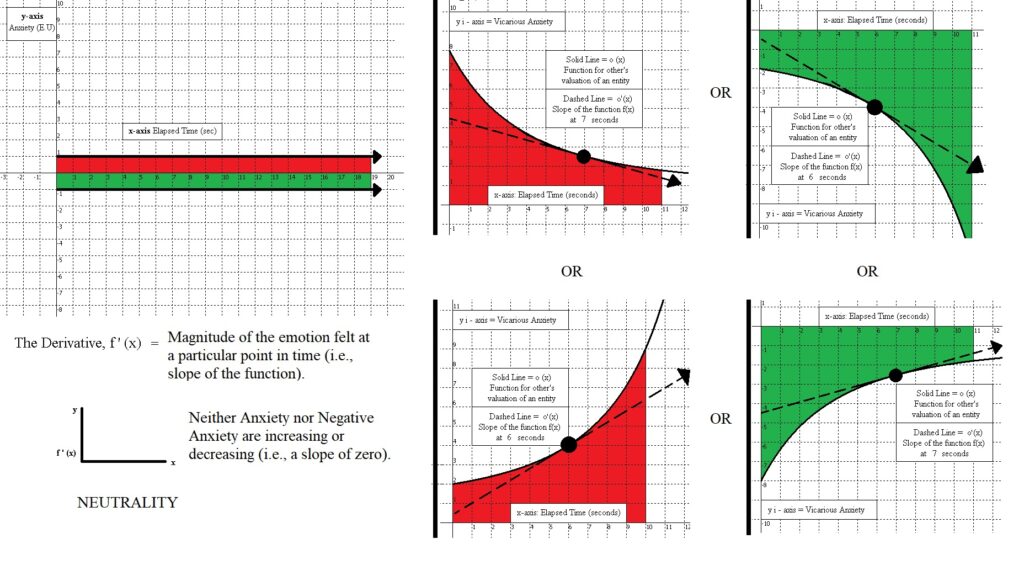
For Loneliness and Vicarious Neutrality, the self would have agency and the graphs would be flipped, with the self’s valuation of an entity being on the right, and their imagining of the other party not reacting to their success or failure on the left.
The Category III Emotions: Compound Interactive Emotions:
The primary distinction between Category III Emotions and Category II Emotions is that for Category III Emotions, the self also has agency, and is able to perform actions that can influence the outcome of the scenario for the other party. Category III Emotions are also comprised of both a Category I and Category II Emotion.
For Category III Emotions, the distinction between Indulgent Type and Protective Type depends on the Appraisal of the entity being valued for actions that the self may take. Indulgent Type emotions involve a negative Appraisal towards the restoration of equilibrium and a Pursuit of Pleasure Emotion for the self. Protective Type emotions involve a positive Appraisal towards the restoration of equilibrium and an Avoidance of Pain emotion for the self.
Lastly, for any of the Protective Type Emotions listed below, Anger may be substituted for Disgust or Relief depending on the approach type used by the self (i.e., aggression, evasion, or neither), as all three are considered Avoidance of Pain Emotions in Affect Engineering.
Benevolence: Indulgent Type and Protective Type
Benevolence entails the self wanting the other party to succeed, and the self successfully performs an action to ensure that the other party succeeds. The other party ultimately succeeds.
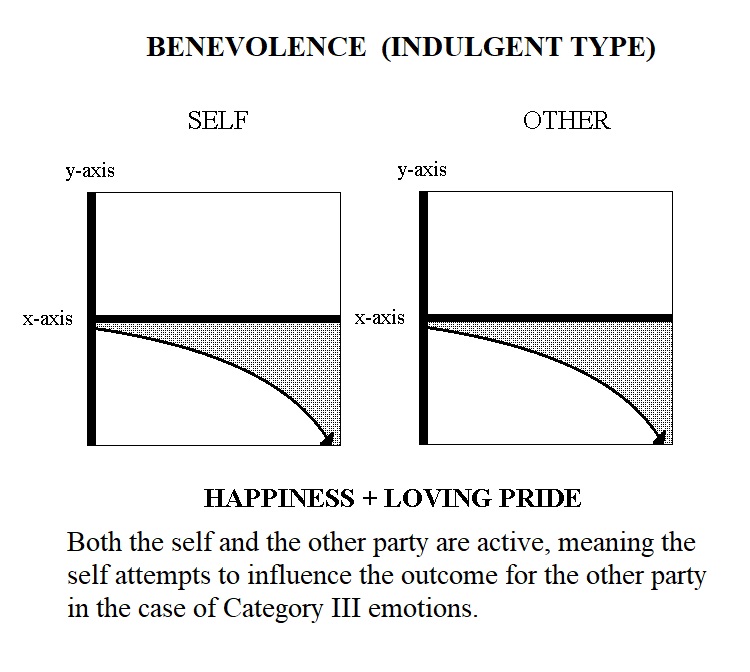
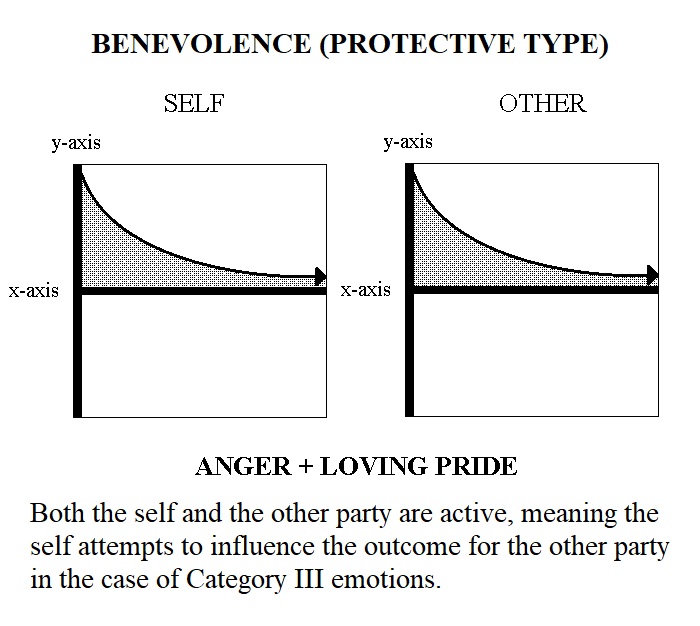
Jealousy: Indulgent Type and Protective Type
Jealousy entails the self wanting the other party to succeed. However, the self is unable to successfully perform an action to ensure that the other party succeeds and the other party ultimately fails. Jealousy’s definition here is more precise and limited, but still in line with the fear of losing loyalty (e.g., to a third party, see jealousy); this definition does not include being covetous, as this would violate the 1:1:1:1 ratio that Affect Engineering adheres towards. Coveting a rival’s situation would be a separate object and would involve a separate emotion. In Affect Engineering, that third party does not need to be another person; it may be any activity or thing that can fulfill the other party’s desire where the self failed to do so.
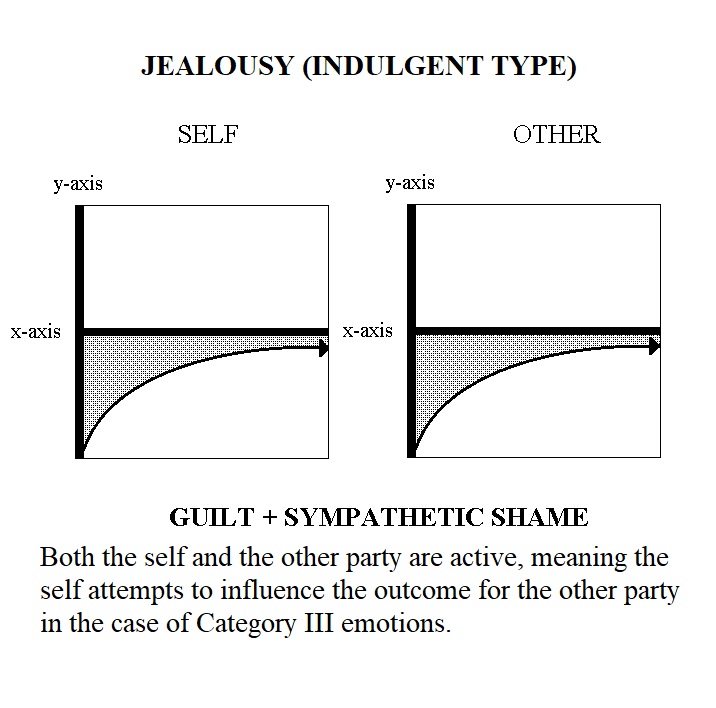
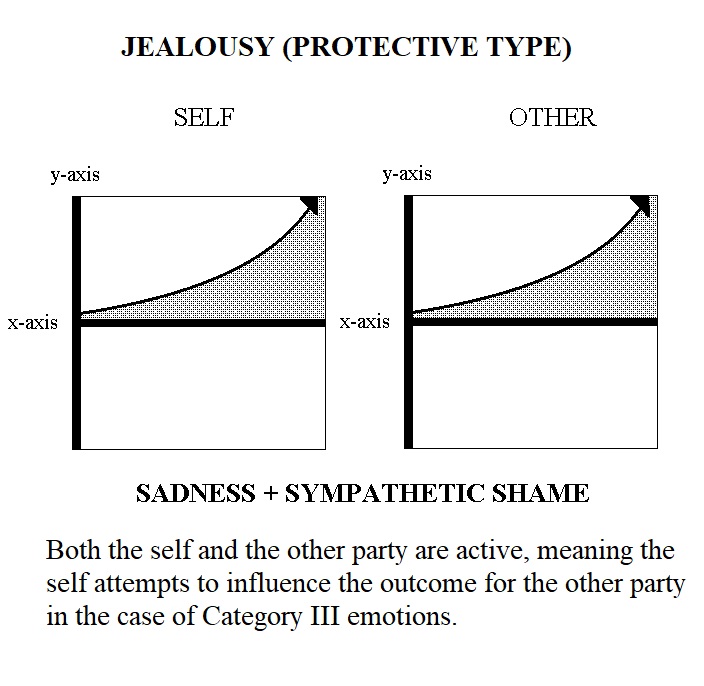
Malevolence: Indulgent Type and Protective Type
Malevolence entails the self wanting the other party to fail. The self is able to successfully performs an action to ensure that the other party fails and the other party ultimately does not succeed.


Envy: Indulgent Type and Protective Type
Envy entails the self wanting the other party to fail. The self is not able to successfully performs an action to ensure that the other party fails and the other party ultimately succeeds. Envy in this context refers to contempt for another’s gain or resentment that arises from the other party’s fortune. The gain, in this case, is the other party escaping a fate that the self considered deserved (e.g., the perception that the other escaped justice). It is comparable to the standard definition of envy, but does not include desiring what the other party has, as this would also violate the 1:1:1:1 ratio in Affect Engineering, in much the same way that being covetous would for jealousy. If the individual desires what the other party has, then that would be a separate purpose and it would involve an additional emotion.
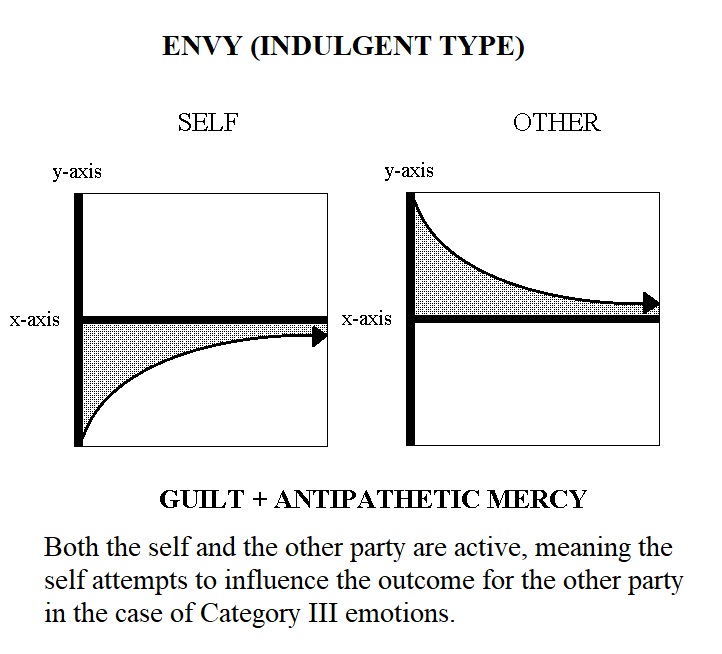
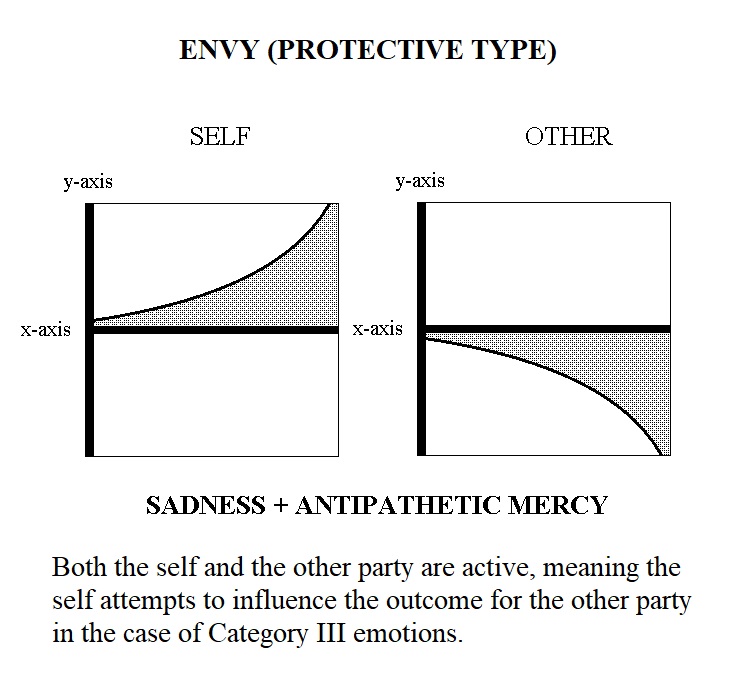
The Category IV Emotions: Emotive States (and other miscellaneous emotions)
Category IV Emotions, or Emotive States, are include all other emotions not mentioned up to this point. As mentioned earlier, Category IV Emotions include those where the duration of the situation is taken into consideration when classifying an emotion, emotions that are characterized by an interplay between three or more objectives, and emotions where certain variables in the functions may be consistently elevated, depressed, unknown, or fluctuating wildly, among other possibilities. Difficult to generalize and culturally specific emotions would often fall under this category, as, more often than not, they are characterized by an interplay between multiple objectives (e.g., three or more). This category is necessarily broader and more expansive than the other three, and permits some flexibility within Affect Engineering’s classification scheme.
Surprise
Surprise felt for an entity is characterized by a sharp change in the valuation of an entity for a purpose. This could be due, for instance, to the Appraisal variable switching from negative to positive or vice versa. A sudden, unexpected change in any other variable could also lead to Surprise arising.
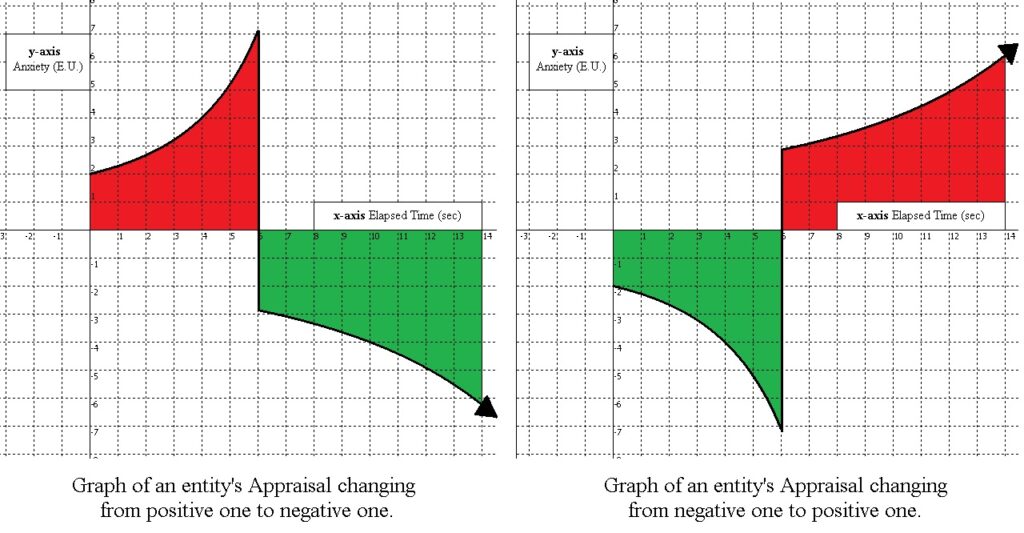
Joyfulness
Joyfulness felt by the self is characterized by the individual having a significant amount of Negative Anxiety invested into several different entities, often times for different purposes. All of the entities all possessed in ample supply and can be stockpiled easily, and with respect to the purpose or purposes at hand, accomplishing them would be relatively easy.
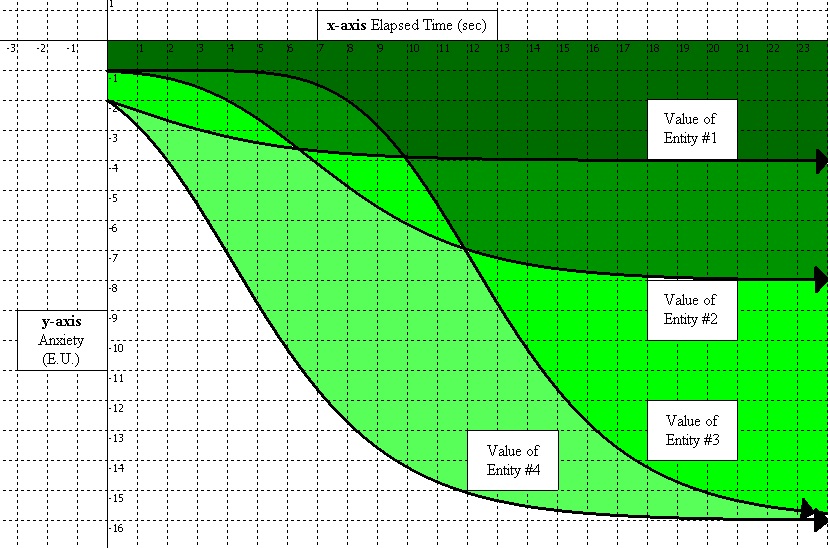
Restlessness
Restlessness felt by the self is characterized by the individual having a significant amount of Anxiety invested into several different entities, often times for different purposes. All of the entities are needed and in short supply. With respect to the purpose or purposes at hand, accomplishing them will be relatively difficult and a general state of unease would be expected. Restlessness would be the counterpart to Joyfulness.

Helplessness
Helplessness felt by the self for an entity is characterized by the individual having a chronically low sense of control over their situation. This could be modeled by low efficacy components, or even an inability of the self to effectively regulate the emotions themselves. Graphs for Helplessness might take on a variety of different appearances.
Confusion
Confusion felt by the self for an entity is characterized by one or more variables in the function being unknown, only known within a certain range, or varying unpredictably from one instance to another. The valuation of the entity for a specific purpose might oscillate within whatever range is possible based on what is known or suspected with the given information the individual knows.
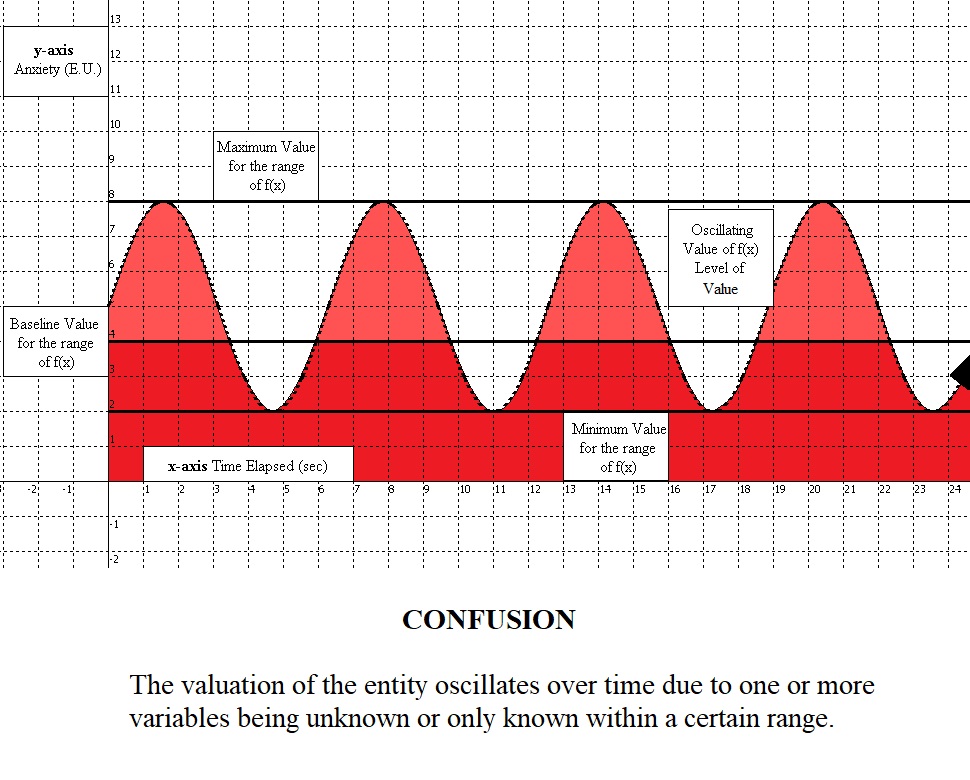
Greed
Greed in Affect Engineering would be modeled as conflict between at least three purposes. The self, by fulfilling one purpose for the self ends up preventing another party from fulfilling a purpose. Moreover, the self wanted the other party to successfully achieve their purpose, but the self’s actions prevented this. A hypothetical scenario will follow to explain this with the author as the subject.
Scenario A: Buying cookies from a pastry shop for friends.
The subject, Marcus, goes to a pastry shop to buy cookies for his friends. His friends want to enjoy some of the pastry shop’s cookies but they cannot get to the shop to order any before it closes. However, Marcus is able to go and he is more than happy to go there and purchase some cookies to make them happy. However, on his way back to delivering them to his friends, the smell of the cookies proves irresistible and Marcus eats all of the cookies before his friends get to try any of them.
The three objectives under consideration:
- Marcus’s friends (the other party) want to eat some cookies from the pastry shop but are unable to go there themselves. Their situation and objectives are experienced vicariously by Marcus (i.e., mirrored).
- Marcus wants to help his friends achieve their objective (eating the cookies) and is able to go to the pastry shop to get the cookies for them.
- Marcus wants to eat the cookies for himself.
The first two objectives would fall under the Category III emotion of Jealousy, and would be of the indulgent type if Marcus simply could not resist the cookies despite having enough of his own. If Marcus was starving to death and the only way to avoid expiring from hunger was by eating the cookies, the case could be made that it was of the protective type, but this would be unlikely. The third objective, wanting to eat the cookies for himself, would fall under the Category I emotion of Happiness and is a separate objective that is in opposition to the other two.
The collective dynamic between these three objectives would be labeled Greed in Affect Engineering. In the image below, Marcus wanting to eat the cookies would be one of the topmost graphs. Marcus wanting to help his friends enjoy some of the cookies but failing to do so would be on of the bottommost graphs below.

Romantic Love, Limerence and Other Emotions
Romantic love, limerence, and some of the more obscure emotions would likely fall under Category IV as many involve an interplay between three or more objectives. These, and other lesser known emotions such as Schadenfreude, Sonder, Callosity, Sehensucht, Hiraeth, and potentially others will be addressed with Category IV Emotions (article 12).
Preview
In the remaining articles, each category of emotion will be examined more in depth with either contemporary examples or hypothetical ones. Some of the relationships between variables will also be explored with sample functions comprised of the variables introduced in the first five articles. A sample function for both the Avoidance of Pain and Pursuit of Pleasure equations is provided below.


The categories of emotions and their application to real life scenarios can, fortunately, be explored without getting into too much of the math.
Previous: Article 5 of 12 Empathy in Affect Engineering
Next: Article 7 of 12 Category I Emotions: Intra-personal Emotions or Emotions of the Self






